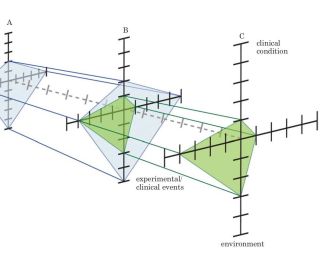Large animal - March 2020
Using learning theory to support vets in multiple teaching roles
Large animal editor Veterinary Ireland Journal, Frank O’Sullivan MVB MRCVS discusses why learning theories are the foundations of success for veterinarians in practice and teaching
Science has been at the core of veterinary interventions, decisions and treatments for veterinary practitioners for many decades. The role of the veterinarian as a teacher has evolved from communication with clients on a one-to-one basis to part-time lecturing in second- and third-level education, and also teaching small groups such as other vets, vet nurses, farmers, and pet owners. However, from an international perspective much of the vet's teaching practice is neither science-based nor supported by learning theory.1 In the university setting, many revert to the traditional lecture method, adopting the expected role as subject expert, imparting information, which is received in a passive way by the students. What sort of learning is happening and how do we know if it is surface or deep learning?2 Furthermore, for many students, a crowded, heavy lecture schedule often ensures that their cognitive load has well surpassed their working memory.3 Formal lectures can seem very long for the majority and student concentration during this type of class seems to drop off after a relatively short period.4,4a
For vets involved in smaller group teaching, although the teaching sessions may be interactive, they often lack structure and, in addition, learning outcomes are often poorly defined and seldom achieved. Science and theory are consistently applied in the veterinary role, but on reflection, there tends to be a lack of scholarship in teaching by vets.
Throughout this article, we will consider how learning theories can become the foundation for improvement in teaching activities. I will tease out how the learning theories support each other, where they are contradictory and how they may inform teaching style and activity. I will contemplate how both teacher and student reflection are a foundational part of the learning theories. I will discuss how case-based learning aids bridge the gap between university education and solving real-world problems5,6 and encourage students to learn collaboratively.7 Finally, I will describe how constructive alignment helps provide a scaffold and overview that helps keep the teaching, together with student activity and learning, on track. I will identify ongoing challenges that vets may encounter as teachers and will explore the literature and experiences of others to help come to a deeper understanding and more nuanced plan of how to formulate teaching plans in the future.
Theoretically speaking
Learning theories, collectively, have promoted engagement in reflective practice as an essential characteristic not only for the development of professional competence as a teacher and veterinary practitioner8 but also for students to engage in effective learning. It is interesting to note that in a career as a veterinarian, ‘reflecting in action’ (eg. during surgery) and ‘reflection on action’ (eg. in herd-health planning) are the preferred norms where a systematic analysis of the farm situation and a reflective process provides for better outcomes.9 However, in the role of a teacher, vets often overlook the beneficial value of reflection both for the students and for themselves as teacher. Application of Kolb's experiential learning theory promotes the understanding that real learning occurs after a cycle of ‘experience, reflection, conceptual and testing’. Kolb’s cycle acts as a reflective revolving cog within constructivism.9a
This interpretation of cognitive constructivism as articulated by Piaget10 challenges an individual involved in teaching to become more of a facilitator than a lecturer where new material is introduced, which the student can firstly discover then internalise, add to existing schemata and form a new perspective or learning. Constructivism helps modify teaching activities and offers the students an opportunity to build a new scaffold as the concepts introduced are layered on previous foundation material. For example, in my teaching experience ‘food safety through the food chain’ was an excellent course topic that facilitated this scaffolding approach. Each week, we critically analysed new concepts linking to the ‘food chain’ from animal welfare to antimicrobial resistance to zoonoses, and so on. This new information was integrated into their existing cognitive schemata forming new schemata with new understanding and learning.
From a personal perspective, having contemplated the constructivism theories, I was directed towards teaching that helped to build schemata. However, these learning theories cultivated some concerns around the pace of my teaching and, in particular, that the rate of introduction of new material may be exceeding the students’ cognitive load as articulated in the Cognitive Load Theory (CLT).11
CLT made me conscious that the teaching activity should not overload the student working memory nor should the teacher be progressing through the course too rapidly and not allow time for the student to process material from the working memory to the long-term memory. Vygotsky helpfully enhanced the understanding that learning takes place in the zone of proximal development (ZPD) where students are challenged and supported to achieve a higher understanding outside of their comfort zone but not so far as to cause confusion or even anxiety.12 The ZPD urges us to reflect on the teaching pace. If it is too slow, some students could remain in their comfort zone and become bored as they already understand the concepts. The challenge is to introduce new material at an appropriate pace for maximum learning. Vygotsky also advocates collaboration with other students and with direction from the teacher, the student will be able to do more and solve increasingly difficult problems that are possible independently.
Overcoming challenges
Although they provide clarity, there are some very significant challenges in application of the learning theories, especially with contemporaneous application of both the CLT and the ZPD in terms of understanding what zone the students were in both individually and collectively. How can we manage to achieve consistent learning outcomes in a timely fashion when working with a diverse group of students from different social and education backgrounds or with language or learning difficulties? Accordingly, it is not easy to be confident that teaching activities are achieving the required learning outcomes in a consistent manner.
Breakthrough
A personal breakthrough providing answers to my queries about learning occurred after discussions with my teaching colleagues and also by asking the students themselves.13 Firstly, I provided the class with relevant background scientific material in advance of introducing a new topic. This background preparatory information consisted of video footage and reading material and was carefully selected, introduced and contextualised so that the students now had the opportunity to engage with the new material at their own pace in preparation for the next lecture. The students then sought to correlate the new knowledge with prior schemata in order to construct a new understanding and be ready for the next lecture.14 As a consequence, there was positive student interaction, which gave me confidence that the student body had acquired a more consistent knowledge foundation and were ready to build new concepts on these foundations. The students themselves suggested that we go on the ‘field visit’ early in the semester so that they could ‘contextualise’ and ‘bring to life” the material in subsequent lectures. They also inquired about using real-life situations and case studies. The students were changing behaviour from being passive participants to taking a lead. I was also transforming from teacher to facilitator, guiding and assisting students in constructing learning for themselves. I appreciated the move towards a deeper learning as they explored topics attempting to relate to other knowledge in their understanding.15
Revision tests
Secondly, subsequent to collective reflection, my teaching peers suggested that I introduce mini revision sessions both at the beginning and end of each lecture. This could take various forms from a quiz or multiple-choice question (MCQ) test, to setting up a class debate or using a video to review material. These formative tests were informal, ongoing and frequent. I found that the students were really engaged and motivated. I used formative assessment not only to keep track and monitor student learning but also to identify students who are struggling. These formative assessments allowed me to ‘reflect in action’ and focus on topics or students that needed attention to individualise learning or indeed to adapt my own approach to teaching a particular subject.16
Small group
Thirdly, social constructivism triggered a paradigm shift within me and directed me towards small-group teaching in order to encourage interaction between students to share knowledge and negotiate a new construct from this knowledge.17 To apply and encourage social constructivism, I utilised small group teaching in conjunction with problem-based learning.18 The smaller group collectively negotiated meaning and built knowledge not as individuals but as a group. I converted my previous two-hour lecture slot into a workshop with diverse, time-bounded learning activities. We rotated the use of models, role play, debates and group work to create a positive dynamic and vibrant learning atmosphere. Role play, in particular, had two specific benefits. Firstly, it allowed allocation of roles to students that are linked to previous experience (and personal schemata) and secondly, we were able to change the scenario to reflect a different circumstance with different learning outcomes.
The students were lively and interested. Initially, I was also challenged as an authority with small group teaching when I essentially ceded power and control to the learners. My relationship with the students changed fundamentally. As facilitator, the role of the teacher is to stimulate critical thinking and support the conversation and occasionally put forward contributing scientific research as required. Collaboration and peer learning helps students, often with different skills and backgrounds, to arrive at a shared understanding. Application of social cognitivism helps students become aware of the assumptions they held and exposed them to different viewpoints and new perspectives.
Facilitation
Something else significant happens with smaller groups and social constructivism. When groups consist of students from diverse cultural and religious backgrounds discussing key issues, they seem to move to a higher level of collaborative critical thinking and this can be very much enhanced and not hindered by the diversity of student cultures.19 Consequently, teachers should look on diversity as a gift and opportunity to be harnessed and understand that diversity may not only reflect different skills and abilities but also assorted personal traits values and attitudes. By harnessing social constructivism, there are significant benefits for students’ lives now and in the future working and living outside the classroom - especially with the additional interpersonal, problem-solving and communication skills they develop. As facilitator we cannot be all things to all people, but it is important to understand that we can facilitate inclusiveness by preparing the class in advance for the dialogue norms of diverse group of students. This is increasingly important in our multi-cultural environment.20
Similarly, social constructivism plays an important role in the vet's work with the farming community through formation of ‘farmer discussion groups’. Vets often act as facilitator and this is acknowledged to be particularly effective in knowledge transfer throughout the European Union. In order to attain effective learning and knowledge transfer, however, discussion groups require support in effective planning and facilitation.21,21a
At the same time, we need to be critically analysing our own teaching and be acutely aware of the importance of being cognisant of the students’ response to our teaching activities.22
Housekeeping
As facilitators we can learn new skills in how to manage group dynamics, with a preference to arrange the chairs in semicircle formation so that everyone (including the facilitator) is equal. Housekeeping rules are also important where everyone, including the facilitator, sits in a circle. With small-group teaching, our role alters from lecturer and knowledge expert to tutor and facilitator. We need to be stimulated to manage the group dynamics by encouraging shy or bored students and governing the dominant or nuisance student (not easy). The teacher can really enjoy this role as we became the ‘devil’s advocate’ and a type of ‘neutral chair’.
The other major issue we encounter is when the collective learner opinion or outcome is contradictory to best scientific practice. As facilitator, it is best practice to politely highlight what is the best science research available. With regards to problem-based learning specifically, learners tend to engage naturally in collaborative problem solving and employ self-directed inquiry and personal reflection in order to create their own path towards a solution, thereby developing new concepts and improve learning.23
A teacher in the facilitation mode learns quickly that there are important rules during small group teaching and facilitation. The optimal group size is around seven or eight learners. If greater, some learners cannot participate or have their voices heard. On the other hand, if the group size is significantly smaller, then the insights arising may be reduced. If the class is bigger it is often useful to divide them into smaller groups to achieve effective learning.24
Personal issues are kept outside and there has to be respect for each other’s opinion. We have also used role play to good effect where different scenarios are acted out in class.26 As facilitator, I personally encourage use of interactive communication skills such as ‘asking open questions’, ‘affirming’, using ‘empathetic listening’ and ‘summarising’. These skills are derived from motivational interviewing (MI)25,25a and are used increasingly in behaviour change in many scenarios and are eminently suited to small group teaching. In addition, it’s very positive to note that during the undergraduate years, vet students from University College Dublin are exposed to problem-based learning, case-based learning and communications training, which are an integral part of their course.
Constructive alignment
Clarity around teaching and learning can improve enormously when we consider the benefits of ‘constructive alignment’ which helps us appreciate the sequential importance and coherence between intended learning outcomes, assessment and teaching strategies in my role as an educator.27,28 On the ‘constructive alignment’ platform we can feel as if we have a beneficial ‘helicopter’ view of the teaching and learning process and the ability to focus the spotlight on individual targets for the benefit of the entire outcome. Taking this as the overarching perspective, we can engage successfully with the university faculty to help redesign the learning outcomes. These learning outcomes may inform both the formative and summative examination material and provide guidance to use novel teaching approaches and activities that ensure engagement and alignment across the spectrum of the module. With regard to the excellent work of Animal Health Ireland in delivering herd health workshops, they have begun to use learning outcomes to define workshop content.
Conclusion
In conclusion, learning theories have facilitated the use of reflection not only for the veterinarian as teacher but also in helping students to use reflection on their way to deeper learning. Science-based teaching skills are essential for veterinarians in all aspects of their professional lives. They can prompt personal and professional growth during the move from lecturer to facilitator. As evidenced above there are many elements of learning theories that resonate positively and it is important to use them in a synergistic fashion. Constructive alignment has been the guiding framework and will continue to direct teaching practise and student activity in the future.
- Kaufman DM. 2003. Applying educational theory in practice. Bmj, 326(7382), pp.213-216.
- Howie P and Bagnall R. 2013. A critique of the deep and surface approaches to learning model. Teaching in Higher Education, 18(4), pp.389-400.
- Young JQ, Van Merrienboer J, Durning S and Ten Cate O. 2014. Cognitive load theory: implications for medical education: AMEE Guide No. 86. Medical teacher, 36(5), pp.371-384.
- Stuart J and Rutherford RD. 1978. Medical student concentration during lectures. The lancet, 312(8088), pp.514-516.
4a. Young MS, Robinson S and Alberts P. 2009. Students pay attention! Combating the vigilance decrement to improve learning during lectures. Active Learning in Higher Education, 10(1), pp.41-55.
5. Thistlethwaite JE, Davies D, Ekeocha S, Kidd JM et al. 2012. The effectiveness of case-based learning in health professional education. A BEME systematic review: BEME Guide No. 23. Medical teacher, 34(6), pp.e421-e444.
6. Milne MJ and McConnell PJ. 2001. Problem-based learning: a pedagogy for using case material in accounting education. Accounting Education, 10(1), pp.61-82.
7. Thurman J, Volet SE and Bolton JR. 2009. Collaborative, case-based learning: how do students actually learn from each other? Journal of veterinary medical education, 36(3), pp.297-304.
8. Mann K, Gordon J and MacLeod A. 2009. Reflection and reflective practice in health professions education: a systematic review. Advances in health sciences education, 14(4), p.595.
9. Vaarst M. 2009. Learning and empowerment in farmer groups as one way of creating a healthy process of animal health and welfare planning. In CORE Organic project nr: 1903-Aniplan. Workshop report-The process of researching animal health and welfare planning (pp. 31-33). Aarhus Universitet-Faculty of Agricultural Sciences.
9a. Holman D, Pavlica K and Thorpe R. 1997. Rethinking Kolb's theory of experiential learning in management education: The contribution of social constructionism and activity theory. Management learning, 28(2), pp.135-148.
10. Amineh RJ and Asl HD. 2015. Review of constructivism and social constructivism. Journal of Social Sciences, Literature and Languages, 1(1),pp.9-16.
11. Sweller J. 2011. Cognitive load theory. In Psychology of learning and motivation (Vol. 55, pp. 37-76). Academic Press.
12. Shabani K, Khatib M and Ebadi S. 2010. Vygotsky's Zone of Proximal Development: Instructional Implications and Teachers' Professional Development. English language teaching, 3(4), pp.237-248.
13. Brookfield SD. 2002. Using the lenses of critically reflective teaching in the community college classroom. New directions for community colleges, 2002(118), pp.31-38.
14. Widmayer SA. 2004. Schema theory: An introduction. Retrieved December, 26, p.2004.
15. Howie P and Bagnall R. 2013. A critique of the deep and surface approaches to learning model. Teaching in Higher Education, 18(4), pp.389-400.
16. Black P and Wiliam D. 2009. Developing the theory of formative assessment. Educational Assessment, Evaluation and Accountability (formerly: Journal of Personnel Evaluation in Education), 21(1), p.5.
17. Duffy TM and Jonassen DH. 1991. Constructivism: New implications for instructional technology?. Educational technology, 31(5), pp.7-12.
18. De Villiers , Bresick, G and Mash B. 2003. The value of small group learning: an evaluation of an innovative CPD programme for primary care medical practitioners. Medical education, 37(9), pp.815-821.
19. Whitla DK, Orfield G, Silen W, Teperow C et al. 2003. Educational benefits of diversity in medical school: a survey of students. Academic Medicine, 78(5), pp.460-466.
20. Warner-Søderholm G and Kriger MP. 2014. The art of dealing with religious and cultural diversity in the classroom.
21. Macken Walshe Á and Byrne A. 2010. Understanding and facilitating farmers adoption of technologies. T-Research.
21a. Vaarst M. 2009. Learning and empowerment in farmer groups as one way of creating a healthy process of animal health and welfare planning. In CORE Organic project nr: 1903-Aniplan. Workshop report-The process of researching animal health and welfare planning (pp. 31-33). Aarhus Universitet-Faculty of Agricultural Sciences.
22. Biggs J. 1999. What the student does: Teaching for enhanced learning. Higher education research & development, 18(1), pp.57-75.
23. Edwards S and Hammer M. 2004. November. Teacher education and problem based learning: Exploring the issues and identifying the benefits. In International Education Research Conference of the Australian Association for Research in Education, Melbourne, Victoria, Australia.
24. Garfield J. 1993. Teaching statistics using small-group cooperative learning. Journal of Statistics Education, 1(1).
25. Miller WR and Rollnick S. 2012. Motivational interviewing: Helping people change. Guilford press.
25a. Miller WR and Mount KA. 2001. A small study of training in motivational interviewing: Does one workshop change clinician and client behavior? Behavioural and Cognitive Psychotherapy, 29(4), pp.457-471.
26. Rao D and Stupans I. 2012. Exploring the potential of role play in higher education: development of a typology and teacher guidelines. Innovations in Education and Teaching International, 49(4), pp.427-436.
27. McMahon T and Forehand M. 2010. Bloom’s taxonomy. Emerging perspectives on learning, teaching, and technology, 41(4), pp.47-56.
28. Thakore H. 2006. Achieving Constructive Alignment: Putting Outcomes First. Quality of Higher Education, 3, pp.10-19.










